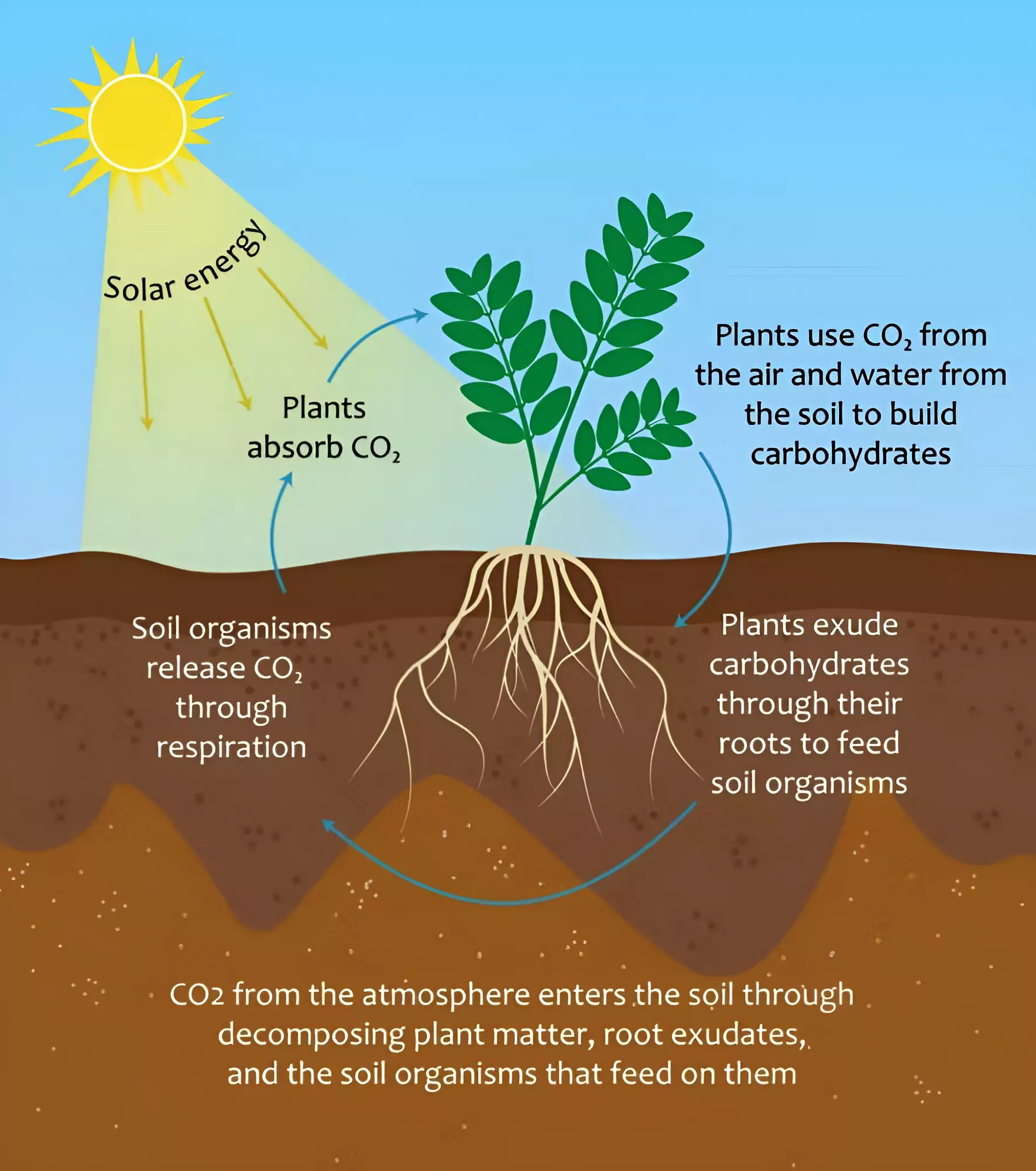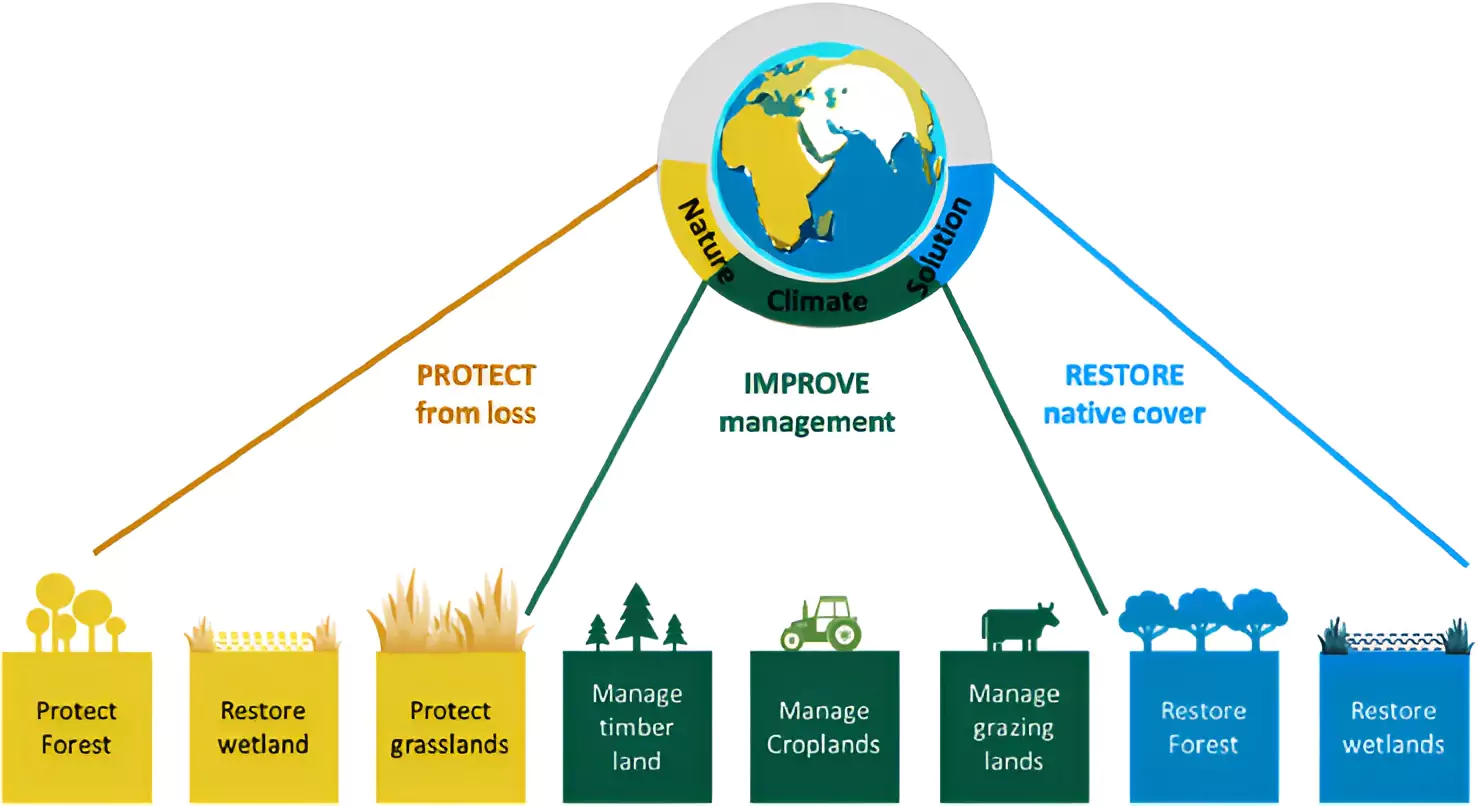Context

Carbon farming can help in restoring ecosystem health while improving agricultural productivity and soil health, and mitigating climate change by enhancing carbon storage in agricultural landscapes and reducing greenhouse gas emissions.
What is Carbon Farming?
Carbon farming combines the concepts of carbon and farming by implementing regenerative agricultural practices. The practice is easy to adopt across various agro-climatic zones. It can help ameliorate soil degradation, water scarcity, and challenges related to climate variability.
- Common Forms of Carbon Farming: It includes rotational grazing, agroforestry, conservation agriculture, integrated nutrient management, agro-ecology, livestock management, and land restoration.
| Carbon: It is found in all living organisms and many minerals. It is fundamental to life on earth and plays a crucial role in various processes, including photosynthesis, respiration, and the carbon cycle.
Farming: It is the practice of cultivating land, raising crops, and/or livestock for food, fibre, fuel, or other resources.
It encompasses a wide range of activities, from planting and harvesting crops to managing livestock and maintaining agricultural infrastructure. |
- Optimal Conditions for Carbon Farming: Regions with long growing seasons, sufficient rainfall, and substantial irrigation provide the best conditions to sequester carbon, through vegetation growth.
- In regions with adequate rainfall and fertile soil, the potential for carbon sequestration through practices like agroforestry (integrating trees and shrubs with crops) and conservation agriculture (minimising soil disturbance) may be particularly high.
Enroll now for UPSC Online Course
Advantages of Carbon Farming
- Diversification of Farm Income: Agroforestry practices including silvopasture and alley cropping can diversify farm income by sequestering carbon in trees and shrubs.
- Enhancement of Soil Health: Conservation agriculture can help minimize soil disturbance and enhance organic content, particularly in places with other intense agricultural activities.
- Conservation agriculture techniques include zero tillage, crop rotation, cover cropping, and crop residue management (stubble retention and composting)
| Silvopasture: It is the integration of trees and grazing livestock operations on the same land. These systems are intensively managed for both forest products and forage, providing both short- and long-term income sources.
Alley cropping: It is defined as the planting of rows of trees and/or shrubs to create alleys within which agricultural or horticultural crops are produced.
Intercropping: It is the practice of growing two or more crops in proximity.
Organic Farming: In this type of farming, organic manure and natural pesticides are used instead of chemicals. No genetic modification is done to increase the yield of the crop. |
- Promoting Soil Fertility: Integrated nutrient management practices promote soil fertility and reduce emissions by using organic fertilizers and compost.
- Ecosystem Resilience: Agro-ecological approaches such as crop diversification and intercropping have benefits for ecosystem resilience.
- Reducing Methane Emissions: Livestock management strategies including rotational grazing, optimising feed quality, and managing animal waste can reduce methane emissions and increase the amount of carbon stored away in pasture lands.
What are the Challenges Related to Carbon Farming in India?
- Limited water availability: It can hinder the growth of plants, thus restricting the potential for sequestration through photosynthesis.
- For example, practices like cover cropping, which require additional vegetation between main crop cycles, may not be viable due to the added water demand.
- Carbon farming can be challenging in hot and dry areas where the availability of water is limited, and prioritized for drinking and washing needs.
- Geographic Location: Geographic factors such as elevation, slope, and proximity to water bodies influence land use options and agricultural productivity. For instance, high-altitude regions may limit crop options due to colder temperatures, while coastal areas may face saltwater intrusion and soil salinity.
| Carbon Sequestration: It is a climate change mitigation technology where CO2 is captured from power plants and other industrial processes instead of being emitted to the atmosphere.
The captured CO2 is then stored in the subsurface with the goal of keeping it out of the atmosphere indefinitely. |
- Plant Selection for Carbon Sequestration: Selecting which plants to grow also becomes crucial because not all species trap and store carbon in the same amounts or in an equally effective manner.
- Financial Constraints: The adoption of carbon farming practices may require financial assistance for farmers to overcome the costs of implementing them.
- In India, small-scale farmers may lack the resources to invest in sustainable land management practices and environmental services.
- Limited Policy Support: A lack of robust policy frameworks and insufficient community engagement restrict the widespread adoption of carbon farming practices, limiting its potential impact on climate change mitigation.
Global Initiatives to Boost Carbon Farming
Chicago Climate Exchange and the Carbon Farming Initiative, Australia: It demonstrates efforts to incentivise carbon mitigation activities in agriculture. The processes range from no-till farming (growing crops without disturbing the soil) to reforestation and pollution reduction.
Kenya’s Agricultural Carbon Project: It highlights the potential for carbon farming to address climate mitigation and adaptation and food security challenges in economically developing countries. 4 per 1000 initiative: It was launched during the COP21 climate talks in 2015 in Paris and aims at increasing soil organic carbon (SOC) sequestration through sustainable practices.
Indian Government Initiatives to Boost Carbon Farming in India
Green Credit Scheme: It aims to promote and support sustainable practices, including those in agriculture.
National Mission on Natural Farming (NMNF): Three main objectives:
- sustainably increasing agricultural productivity and incomes
- adapting and building resilience to climate change
- reducing greenhouses gas emissions wherever possible
What Are the Opportunities in India?
- Viability of Organic Farming: Grassroots initiatives and pioneering agrarian research in India are demonstrating the viability of organic farming to sequester carbon.
 In this regard, agro-ecological practices in India could yield significant economic benefits, with the potential to generate $63 billion in value from approximately 170 million hectares of arable land.
In this regard, agro-ecological practices in India could yield significant economic benefits, with the potential to generate $63 billion in value from approximately 170 million hectares of arable land.
- Suitability Across Geographic Regions: Regions with extensive agricultural land, such as the Indo-Gangetic plains and the Deccan Plateau, are well suited to adopt carbon farming whereas the mountainous terrain of the Himalayan region is less suited.
- Coastal areas are prone to salinisation and have limited access to resources, thus limiting the adoption of traditional farming practices.
- Enhancing Food Security: Carbon credit systems can incentivise farmers by providing additional income through environmental services.
- Agricultural soils can absorb 3-8 billion tonnes of CO2-equivalent every year over 20-30 years.
- This can bridge the gap between feasible emissions reductions and the indispensable stabilisation of the climate.
- Thus, carbon farming could also be a sustainable strategy to mitigate climate change and enhance food security in India.
Enroll now for UPSC Online Classes
How Can India Promote Carbon Farming More Effectively?
India can encourage carbon farming more effectively through a variety of strategies, including:
- Legal Framework for Carbon Farming: Establish comprehensive carbon farming legislation to promote carbon sinks on agricultural lands, addressing climate crises and improving agricultural sustainability.
- Direct Incentives for Farmers: Provide direct incentives, such as tools and credit support, to encourage adoption of climate-friendly practices in the agriculture and forestry sectors.
- Utilizing Carbon Credits and Banks: Reward farmers with globally tradable carbon credits and establish carbon banks to incentivize carbon sequestration efforts and promote sustainable land management.
- Collective Engagement: Foster cohesive policies, public-private partnerships, precise quantification methods, and supportive financing mechanisms for scalable carbon farming implementation.
- Unlocking Soil Potential: Recognize soil’s potential as a potent carbon sink and harness it to meet Net Zero goals and drive decarbonization.
Conclusion
Scaling Carbon farming in India would require concerted efforts to address challenges of limited awareness, inadequate policy support, technological barriers, and an enabling adoption environment. Promoting carbon farming is in India’s interests to mitigate climate change while improving soil health, enhancing biodiversity, and creating economic opportunities for its adopters.
Also Read: Agroforestry Carbon Market, Organic farming
![]() 10 May 2024
10 May 2024


 In this regard, agro-ecological practices in India could yield significant economic benefits, with the potential to generate $63 billion in value from approximately 170 million hectares of arable land.
In this regard, agro-ecological practices in India could yield significant economic benefits, with the potential to generate $63 billion in value from approximately 170 million hectares of arable land. 